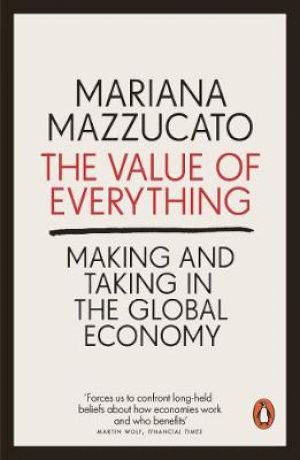20 November 2018
The Value of Everything
Making and Taking in the Global Economy
Mariana Mazzucato
2018, Allen Lane, 384 pages,
ISBN 9780141980768
Reviewer: Rosemary Connell

Why do the takers (owners of capital) make so much money while the makers (workers) make so little? Value extraction via share buybacks, ( giving managers generous share options and boosting EPS), putting companies into administration having sucked out money in dividends, or complex tax arrangements are all examples or value extraction, reducing funds available for investment in capital and research. The author gives detailed examples and, interestingly, goes on to chart the history of how economists have debated productive versus unproductive activities over the centuries. The theories of classical economists (eg Ricardo, Marx) were subsequently overturned by the neoclassicals (Walras, Jevons, Menger, Marshall). The concepts of scarcity and marginalism were developed at this stage of economic thought.
The History of National Accounts includes an analysis of the oddities in the way some sectors are valued or not valued. A lot of Government activities are provided free or below market prices so the usual way of calculating value added for business does not work. The financial sector, formerly seen as an unproductive distributor of wealth, is now classified as a creator of value in National accounts even though some of its activities extract value rather than create it.
The phenomenon of financialization is examined and its expansion beyond the banks to other fund managing intermediaries. The effects of Private Equity are exposed. The crash of 2008 vindicated those economists like Keynes who had warned of the dangers of excessive financialization and its capacity for value extraction. Financialization has also permeated the manufacturing sector; for example, in the 2000s Ford made more from selling loans than selling cars.
The financial sector grew rapidly especially in the developed world, as did assets under management (in the USA from $3.1 billion in 1951 to $17 trillion in 2015). Fund managers diversified into hedge funds, private equity and venture capital. Factors that led to their development are examined, as are the resultant extraction of value and rise in inequality. US mutual fund charges have risen despite the huge rise in assets managed.
It is argued that short-termism, reducing tenure of CEOs, cost cutting, downsizing, a rising percentage of cash flows being returned to shareholders together with financial engineering have all contributed to the lack of long-term investment.
If one recognises that value creation is a collective activity then it should be measured by stakeholder value not shareholder value.
Value extraction in the “innovation” economy (e.g. Silicon Valley entrepreneurs) is discussed with extensive examples including patent blocking to preserve competitive advantage.
The author argues that governments are undervalued as wealth creators. Rather than being seen as necessary but unproductive spenders and regulators the public sector also creates markets, funds key technologies and invests in infrastructure. As long as funds are invested productively in sectors that increase productivity as, for example, in research and education, the debt/GDP denominator will rise keeping the ratio in check. What matters is not the deficit created, but how governments invest funds. Austerity is not the solution. Outsourcing is found to be inefficient.
Real reform of the economic system will depend on identifying which processes create economic value and then promoting them while controlling processes that extract value. The author exposes the myths surrounding value creation and extraction. Completely new thinking will be required to provide a better future.
This is an admirably researched and provocative book that should provide for heated and wide-ranging debates on what creates value and how this can be nurtured.
